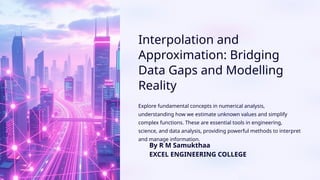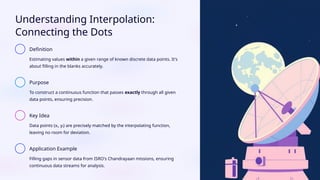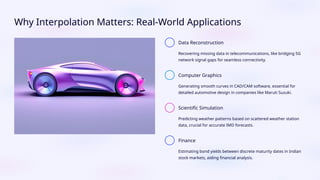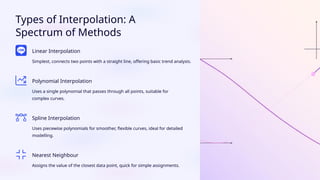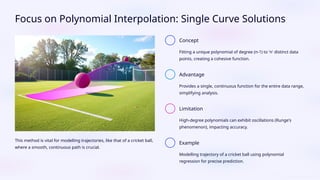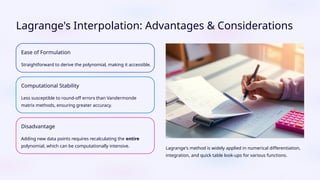Interpolation-and-Approximation-Bridging-Data-Gaps-and-Modelling-Reality.pptx
- 1. Interpolation and Approximation: Bridging Data Gaps and Modelling Reality Explore fundamental concepts in numerical analysis, understanding how we estimate unknown values and simplify complex functions. These are essential tools in engineering, science, and data analysis, providing powerful methods to interpret and manage information. By R M Samukthaa EXCEL ENGINEERING COLLEGE
- 2. Understanding Interpolation: Connecting the Dots Definition Estimating values within a given range of known discrete data points. It's about filling in the blanks accurately. Purpose To construct a continuous function that passes exactly through all given data points, ensuring precision. Key Idea Data points (xᵢ, yᵢ) are precisely matched by the interpolating function, leaving no room for deviation. Application Example Filling gaps in sensor data from ISRO's Chandrayaan missions, ensuring continuous data streams for analysis.
- 3. Why Interpolation Matters: Real-World Applications Data Reconstruction Recovering missing data in telecommunications, like bridging 5G network signal gaps for seamless connectivity. Computer Graphics Generating smooth curves in CAD/CAM software, essential for detailed automotive design in companies like Maruti Suzuki. Scientific Simulation Predicting weather patterns based on scattered weather station data, crucial for accurate IMD forecasts. Finance Estimating bond yields between discrete maturity dates in Indian stock markets, aiding financial analysis.
- 4. Types of Interpolation: A Spectrum of Methods Linear Interpolation Simplest, connects two points with a straight line, offering basic trend analysis. Polynomial Interpolation Uses a single polynomial that passes through all points, suitable for complex curves. Spline Interpolation Uses piecewise polynomials for smoother, flexible curves, ideal for detailed modelling. Nearest Neighbour Assigns the value of the closest data point, quick for simple assignments.
- 5. Focus on Polynomial Interpolation: Single Curve Solutions This method is vital for modelling trajectories, like that of a cricket ball, where a smooth, continuous path is crucial. Concept Fitting a unique polynomial of degree (n-1) to 'n' distinct data points, creating a cohesive function. Advantage Provides a single, continuous function for the entire data range, simplifying analysis. Limitation High-degree polynomials can exhibit oscillations (Runge's phenomenon), impacting accuracy. Example Modelling trajectory of a cricket ball using polynomial regression for precise prediction.
- 6. Lagrange's Interpolation Formula: Elegant Simplicity Concept Constructs the interpolating polynomial using Lagrange basis polynomials, a foundation of numerical methods. Formula P(x) = Σ yᵢ * Lᵢ(x), where Lᵢ(x) are basis polynomials, offering a clear, direct approach. Advantage No need to solve a system of linear equations (unlike Newton's form), simplifying computation. Uniqueness The resulting polynomial is unique for a given set of points, ensuring consistent results. Development Named after Joseph-Louis Lagrange, an influential 18th-century mathematician whose work remains pivotal.
- 7. Lagrange's Interpolation: Advantages & Considerations Ease of Formulation Straightforward to derive the polynomial, making it accessible. Computational Stability Less susceptible to round-off errors than Vandermonde matrix methods, ensuring greater accuracy. Disadvantage Adding new data points requires recalculating the entire polynomial, which can be computationally intensive. Lagrange's method is widely applied in numerical differentiation, integration, and quick table look-ups for various functions.
- 8. Introduction to Approximation: Simplifying Complexity Definition Finding a simpler function that "best fits" a more complex function or data, simplifying interpretation. Purpose To reduce computational cost, filter noise, or compress data efficiently. Key Idea The approximating function doesn't necessarily pass through all points exactly, prioritising overall fit. Metrics Measured by error, such as Root Mean Square Error (RMSE), to gauge the accuracy of the fit.
- 9. Approximation Techniques: Best Fit vs. Exact Fit These techniques enable efficient data storage, as seen in image compression standards like JPEG, balancing quality with file size. Least Squares Approximation Minimises the sum of squared differences, robust to noise and outliers. Fourier Series Approximation Represents periodic functions as a sum of sines/cosines, ideal for signal processing. Chebyshev Approximation Minimises maximum error over an interval (minimax criterion), ensuring even error distribution. Application Example Noise reduction in audio processing for Indian classical music recordings, enhancing clarity.
- 10. Conclusion: Powerful Tools for Data Science & Engineering Interpolation Connects known points precisely, critical for reconstruction and smooth representation of data. Approximation Simplifies complex data, crucial for efficiency, noise reduction, and generalisation. Lagrange's Method A fundamental and elegant approach in polynomial interpolation, foundational for numerical analysis. Future Scope Advances in machine learning models are increasingly incorporating these numerical techniques for complex data analysis.
